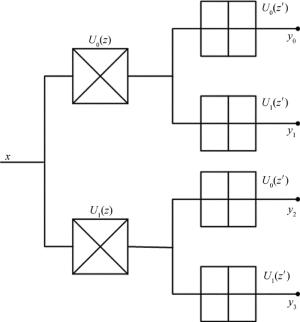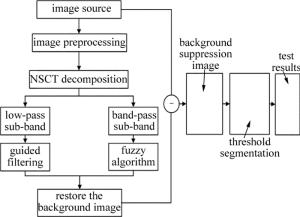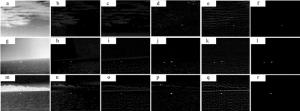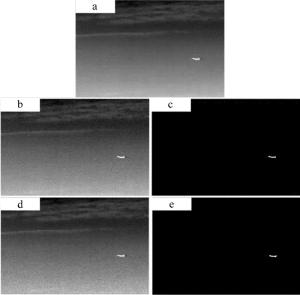-
随着成像技术的发展, 红外成像系统大规模用于军事、民用等诸多领域, 各种航空、航海设备的发展使得成像系统中的关键技术——小目标探测受到越来越多的关注。但是小目标在红外图像中所占像素点少, 且形状、纹理模糊, 还易受到复杂背景如各类杂波噪声、海天线、云层等影响, 这些因素严重降低了小目标跟踪和检测的精度。因此, 要从低信噪比的红外图像中精确检测出小目标, 就必须对红外图像的背景进行抑制处理。
红外小目标图像检测方法主要分为变换域[1]、空间域[2-3]和时间域[4-5]等方法。空间域和时间域方法主要利用背景、目标在空间上的特性或者借助形态学算子对背景抑制。而基于变换域方法主要是将输入图像分解到不同子带上, 然后再对各子带系数进行处理以抑制背景杂波。这类方法主要包括轮廓波变换、小波域变化、脊波变换[6]等。但当检测信噪比较低的图像时, 效果较差。为了精确、高效地检测红外小目标信息, 研究者通常会将变换域方法和空间域或者时间域的方法或者其它方法相结合。WU等人[7]提出了基于非下采样轮廓波(non-subsampled contourlet transform, NSCT)的红外图像小目标检测技术, 但是并没有对分解的高低频子带进行处理, 具有较高的虚警率。QIN等人[4]基于非下采样方向滤波器组的红外复杂地面背景抑制, 通过傅里叶变换调整各方向子带分离杂波与目标, 但算法复杂性较大。WU等人[8]提出联合NSCT和奇异值分解(singular value decomposition, SVD)算法的红外弱小目标复杂背景抑制方法, 使用SVD对高频子带处理, 但忽略了低频子带, 降低了背景抑制效果。FENG[9]在原有奇异值分解的基础上进行改进, 虽然增强了目标边缘, 但是背景抑制程度并没有显著改善。
作者针对NSCT分解后各子带存在的一些问题, 提出基于引导滤波和模糊算法的NSCT域的红外小目标背景抑制算法, 通过非下采样轮廓波分解得到低通子带和带通子带, 采用引导滤波和模糊算法分别对低通子带、带通子带处理, 最后利用NSCT逆变换得到的背景抑制图像。
-
2006年, da CUNHA等人[10]在contourlet理论[11]的基础上提出了非下采样contourlet变换, 通过图像的多方向、多尺度分解克服了contourlet平移变化导致的频谱重叠等缺陷, 使其具备了很好的特征提取性能。NSCT由非下采样塔式滤波器组(non-subsampled pyramid filter bank, NSPFB)和非下采样方向滤波器组(non-subsampled directional filter bank, NSDFB)构成。NSCT分解是一个迭代过程, 输入图像首先经过NSPFB分解得到与原图大小一致的带通子带、低通子带; 其次NSPFB继续对得到的低通子带进行重复迭代操作。图 1所示为迭代3次的NSPFB分解。
NSCT第二部分由NSDFB将分解得到的所有带通子带在不同方向继续分解, 图 2所示为NSDFB 2级分解。最终输入图像经过NSCT分解后得到一个低通子带和多个子带图像。
NSCT总体分解图如图 3所示。
-
引导滤波(guided image filtering, GIF)[12-13]在图像平滑、增强等领域有较好的效果, 其算法难易程度与滤波窗口半径无关, 可以降低运算量。
本方法局部线性模型为:
$ {q_i} = {a_k}{g_i} + {b_k}, (i \in {\omega _k}) $
(1) 式中, i和k是像素索引, gi是引导图像的值, qi是输出值, ak, bk是当中心窗口ω位于k时该函数的系数。然后由参考文献[14]中引入代价函数, 表示为:
$ E({a_k}, {b_k}) = \sum\limits_{i \in {\omega _k}} {\left[ {{{\left( {{a_k}{g_i} + {b_k} - {p_i}} \right)}^2} + \varepsilon {a_k}^2} \right]} $
(2) 式中, ε是平滑因子, 用来限制ak的取值, pi是输入图像p对应的值。通过最小二乘法, 可以得到ak, bk, 表达式为:
$ {a_k} = \frac{{\frac{1}{{|\omega |}}\sum\limits_{i \in {\omega _k}} {{g_i}{p_i}} - {\mu _k}{{\bar p}_k}}}{{\sigma _k^2 + \varepsilon }} $
(3) $ {b_k} = {{\bar p}_k} - {a_k}{\mu _k} $
(4) 式中, μk和σk2是引导图g的均值和方差, |ω|是窗口包含的像素数, pk是输入图像p在窗口中的均值。如果想具体求某一点的输出值时, 将该点所参与的全部线性函数值平均即可, 表达式如下:
$ {a_i} = \frac{{\sum\limits_{k \in {\omega _k}} {({a_k}{g_i} + {b_k})} }}{{|\omega |}} = {{\bar a}_i}{g_i} + {{\bar b}_i} $
(5) 通过(1)式求得梯度保持函数▽q=a▽g。综上所述, 处理图像q较多的保留引导图g所包含的信息。经过引导滤波处理的图像, 不仅可以平滑背景噪声, 还能有效增强图像边缘, 提高图像信噪比。
-
有学者提出了一种隶属度函数和模糊增强算法[15], 其本质是用某种变换函数将图像映射为一个矩阵, 利用模糊集理论对其进行处理, 但是该算法存在一些缺点, 如渡越点的选取靠多次实验或个人经验, 对实验结果有较大影响, 采用最大类间方差法算法通过自动选取阈值实现渡越点的自动获取[16], 同时为了减少不必要的计算, 简化计算流程, 对算法的模糊隶属函数修改如下:
$ {u_{ij}} = {\{ \sin [\frac{{\pi (f - {f_{\min }})}}{{2({f_{\max }} - {f_{\min }})}}]\} ^r} $
(6) $ {F_1}({\mu _{ij}}) = \left\{ \begin{array}{l} 2{({\mu _{ij}})^2}, (0 \le {\mu _{ij}} \le {u_{\rm{c}}})\\ 1 - 2{(1 - {\mu _{ij}})^2}, ({u_{\rm{c}}} \le {\mu _{ij}} \le 1) \end{array} \right. $
(7) 式中, fmax, fmin对应图像像素中最大值、最小值; r为迭代次数, 可取为1, 2, …; uc是由渡越点决定。然后随着隶属度函数的确认, 通过模糊算子把图像映射到空间域, 最后通过反变换得到处理图像。
-
将原图像利用NSCT分解的主要目的是为了得到与输入图像相同大小的低通子带图像和带通子带图像。但是随着NSCT分解尺度的增加, 会出现噪声影响, 且图像对比度没有提高, 难以分离目标与背景。当源图像属于云背景时, 目标被云层遮挡, 难以正确区分背景与目标。综合上述因素, 提出对分解的低通子带和带通子带继续进行处理, 具体步骤如下:(1)利用NSCT算法对原始图像分解, 获得低通子带图像和带通子带图像; (2)将低通子带图像通过引导滤波去除噪声, 平滑图像背景; (3)对带通子带图像采用模糊算法处理, 得到除目标之外的纹理信息; (4)将上述处理得到的图像通过逆变换获得背景预测图像。算法流程图如图 4所示。
-
为了检验本文中的算法在背景抑制方面的效果, 采用天空背景、海天线背景和海面多目标等3组代表性较强的红外图像进行实验, 并用本文中的方法与基于顶帽变换(top-hat)、引导滤波(guided image filter-ing, GIF)、鲁棒性主成分分析(robust principal component analysis, RPCA)和NSCT的4种背景抑制方法比较。使用均方误差(mean-square error, MSE)和峰值信噪比(peak signal-to-noise ratio, PSNR)体现算法在背景抑制方面的性能, MSE用于计算图像背景与预测背景平均误差大小, 误差结果与所计算数值成反比。PSNR所计算数值与目标增强效果成正比。通过对MSE和PSNR的性能指标分析可以得出, 本文中的方法较其它背景抑制算法有一定优势。算法运行环境基于Inter双核3.2GHz, 内存4.0GB的PC机和MATLAB 2014b软件平台。图 5为实验结果。
表 1为5种实验方法对应指标, 本文中的方法与其它4种方法在峰值信噪比方面有了一定的提高, 均方误差显示, 预测背景与真实背景接近。由此表明作者提出的方法对多种复杂红外小目标背景都适用。
Table 1. Comparison among the experimental results
Fig. 5m Fig. 5g Fig. 5a MSE PSNR MSE PSNR MSE PSNR top-hat 16.6446 32.8435 13.0185 36.7370 12.3329 36.1820 GIF 15.5397 33.1418 13.0016 36.7426 12.0448 36.2847 RPCA 10.5324 34.8309 6.6929 36.8000 6.2712 37.0826 NSCT 25.6984 30.9572 10.8570 37.1255 5.8153 39.4470 algorithm of this paper 9.9399 35.0824 5.8548 37.3811 5.1063 40.0116 红外图像在其采集、转存过程都会受到噪声影响, 例如:高斯噪声、斑点噪声、椒盐噪声等一系列噪声, 高斯噪声是一种随机噪声, 其值按高斯概率定律分布; 斑点噪声则是随机散射形成的, 在图像上表现为小斑点, 噪声的存在严重影响图像质量, 因此消除噪声格外重要, 为了验证本文中的算法的鲁棒性, 在天空背景红外图像中分别加入高斯噪声、斑点噪声, 采用本文中的算法对其处理。
图 6为实验结果。图 6a为天空背景图像; 分别加入高斯噪声和斑点噪声, 如图 6b和图 6d所示; 将噪声图像通过本文中的算法处理得到的实验结果如图 6c和图 6e所示, 由于算法在低通子带及带通子带部分分别采用引导滤波和模糊算法, 在平滑噪声的同时加强了目标边缘, 因而能够提取完整地目标区域, 证明了算法的有效性。
-
针对红外小目标检测过程中易受到复杂背景、各种杂波的影响, 提出了一种基于引导滤波与模糊算法结合的背景抑制方法, 利用NSCT分离背景和目标, 通过引导滤波和模糊算法对噪声、纹理进去处理, 对不同背景的红外小目标进行实验。由上述实验结果可知, 本文中的算法具有较好的背景抑制效果, 并且能够抑制杂波、消除噪声、降低虚警率, 可较好地检测小目标, 提高对红外小目标的探测能力, 并为后续的目标识别处理和运动轨迹检测打下坚实基础。
基于引导滤波和模糊算法的红外背景抑制算法
Infrared background suppression algorithm based on guided filtering and fuzzy algorithm
-
摘要: 为了减少背景对红外小目标检测结果的影响,同时降低检测虚警率,采用了基于引导滤波和模糊算法的红外背景抑制算法,利用非下采样轮廓波多尺度、多方向的分解机制,将红外序列图像分解为低通子带和带通子带;再利用引导滤波对低通子带处理,以平滑图像、抑制噪声、增强背景细节;带通子带则采用模糊算法处理,实现目标和残留背景分离;最后将各子带图像通过非下采样轮廓波逆变换,得到了背景抑制图像。结果表明,该方法可以将均方误差降至5~10,有效抑制了背景,突出了目标。该研究为提高复杂背景下的红外小目标检测精度提供了支持。Abstract: In order to reduce the influence of background on detection results of infrared small targets and reduce false alarm rate, infrared background suppression algorithm based on guidance filter and fuzzy algorithm was adopted. The infrared image was decomposed into low-pass band and band-pass band by using multi-scale and multi-direction decomposition mechanism of non sampled contour. The guided filter was used to process low-pass sub-band to smooth images, suppress noise and enhance background details. Band-pass sub-band was processed by fuzzy algorithm to seperate the target from the residual background. Background suppression image was obtained by changing subband images through non subsampled contour inversion. The results show that, the method can reduce mean square error to 5~10, and effectively suppress the background and highlight the target. This study provides the support for improving the detection accuracy of infrared small targets in complex background.
-
Table 1. Comparison among the experimental results
Fig. 5m Fig. 5g Fig. 5a MSE PSNR MSE PSNR MSE PSNR top-hat 16.6446 32.8435 13.0185 36.7370 12.3329 36.1820 GIF 15.5397 33.1418 13.0016 36.7426 12.0448 36.2847 RPCA 10.5324 34.8309 6.6929 36.8000 6.2712 37.0826 NSCT 25.6984 30.9572 10.8570 37.1255 5.8153 39.4470 algorithm of this paper 9.9399 35.0824 5.8548 37.3811 5.1063 40.0116 -
[1] RONG Sh H, LIU G, ZHOU H X, et al. Infrared dim and small target background suppression based on the improved shearlet transformand the guide filter[J]. Acta Photonica Sinica, 2015, 44(2):210002(in Chinese). doi: 10.3788/gzxb [2] YAN G Sh, BI W Zh. Detection algorithm of small target based on regional singularity filter[J]. Optical Technique, 2007, 33(2):163-152(in Chinese). [3] QIN H L, ZHOU H X, LIU Sh Q, et al. Total variation for dim and small target background suppression[J]. Optical Technique, 2009, 35(4):596-598(in Chinese). [4] QIN H L, YAO K K, ZHOU H X, et al. Nonsubsampled directional filter banks for infrared complex ground background suppression[J]. Semiconductor Optoelectronics, 2011, 32(4):560-563(in Ch-inese). [5] LI J, MA J N, LI Sh J, et al. Background suppression for infrared dim small target detection based on spatial-temporal filter[J]. Semiconductor Optoelectronics, 2017, 38(3):396-400(in Chinese). [6] GE W, JI P Ch, ZHAO T Ch. Infrared and visible light images fusion of fuzzy logic on NSST domain[J]. Laser Technology, 2016, 40(6):892-896(in Chinese). [7] WU Y Q, LUO Z J, WU W Y. A method of small target detection in infrared image based on non-subsampled contourlet transform[J]. Journal of Image & Graphics, 2009, 14(3):477-481(in Chinese). [8] WU T A, HUANG Sh C, YUAN Zh W, et al. NSCT combined with SVD for infrared dim target complex background suppression[J]. Infrared Technology, 2016, 38(9):758-764(in Chinese). [9] FENG Y. Detection of dim and small infrared targets based on the improved singular value decomposition[J]. Laser Technology, 2016, 40(3):335-338(in Chinese). [10] da CUNHA A L, ZHOU J, DO M N. The non-subsampled contourlet transform:theory, design and applications[J]. IEEE Transactions on Image Proecessing, 2006, 15(10):3089-3101. doi: 10.1109/TIP.2006.877507 [11] PENG Zh, ZHAO B J. Novel scheme for infrared image enhancement based on contourlet transform and fuzzy theory[J]. Laser & Infrared, 2011, 41(6):635-640(in Chinese). [12] HE K, SUN J, TANG X OU. Guided image filtering[J]. IEEE Transactions on Pattern Analysis & Machine Intelligence, 2013, 35(6):1397-1409. [13] LI X H, DONG A G, FENG J H. Regional fusion algorithm of i-mages based on multistage guide filters[J]. Laser Technology, 2016, 40(5):756-761(in Chinese). [14] KANG Ch Q, CAO W P, HUA L, et al. Infrared image denoising algorithm via two-stage 3-D filtering[J]. Laser & Infrared, 2013, 43(3):261-264(in Chinese). [15] ZHANG W. An improved method of image fuzzy enhancement[J]. Life Science Instruments, 2006, 4(3):29-31(in Chinese). [16] LUO Y, YANG H M. An improved fuzzy enhancement algorithm of robot digital landmark based on Otsu adaptive threshold[J]. Optics & Optoelectronic Technology, 2010, 8(1):35-38(in Chinese). -


 网站地图
网站地图

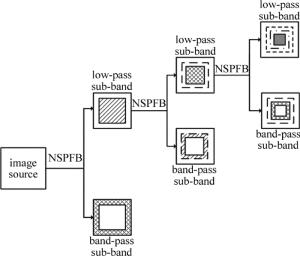
 下载:
下载:
